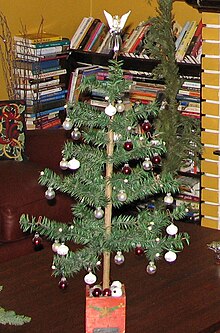Feathers
An example of an antique feather Christmas tree
Feather Christmas trees, originally of German origin, became popular in the United States as well. Feather trees were initially made of green-dyed goose feathers which were attached to wire branches. These wire branches were then wrapped around a central dowel which acted as the trunk Feather Christmas trees ranged widely in size, from a small 2 inch tree to a large 98 inch tree sold in department stores during the 1920s. Often, the tree branches were tipped with artificial red berries which acted as candle holders. The branches were widely spaced to keep the candles from starting a fire, which allowed ample space for ornamentation. Other benefits touted for feather trees included the elimination of a trip to the tree lot and the lack of shed needles.
Brush bristles
In 1930 the U.S.-based Addis Brush Company created the first artificial Christmas tree made from brush bristles. The company used the same machinery that it used to manufacture toilet brushes. The trees were made from the same animal-hair bristles used in the brushes, save they were dyed green. For a time, the brush trees were immensely popular, with large numbers exported to Great Britain, where the trees also became popular. These brush trees offered advantages over the earlier feather trees. They could accept heavier ornamentation, and were not nearly as flammable.
Aluminium
An aluminium Christmas tree
Aluminium Christmas trees are a type of artificial tree that are made largely from aluminium. The trees were manufactured in the United States, first in Chicago in 1958, and later in Manitowoc, Wisconsin where the majority of the trees were produced. Aluminum trees were manufactured into the 1970s, and had their height of popularity from their inception until about 1965. That year A Charlie Brown Christmas aired for the first time, and its negative portrayal of aluminium Christmas trees is credited for a subsequent decline in sales.
Plastic
Most artificial Christmas trees are made from PVC plastic. PVC trees are fire-retardant but not fire-resistant. Many of these trees are made in China; from January to August 2005 $69 million worth of artificial trees from Chinaentered the United States.
The Prelit Tree has become increasingly popular in the United States and Germany as well, most prelit trees are not made from recycled plastic materials because all prelit trees are being classified into the categories of electrical products and are subject to the mandatory regulations for the safety standards of electrical products e.g. UL, CSA, GS, BS and RoHS. Artificial Christmas trees may be "frosted" or "glittered" and designed for outdoor uses with UV additives. Plastic trees can come in a variety of different colors, and one type came with built-in speakers and an MP3 player.
Companies such as Mountain King, Barcana and the National Tree Company have marketed increasingly realistic PVC trees made to closely resemble Douglas fir, Ponderosa pine or other common types of Christmas trees. During the 1990s trees not only began to appear more realistic but some also smelled more realistic. Many of these more modern models came with pre-strung lights and hinged branches which simply had to be snapped into position.


